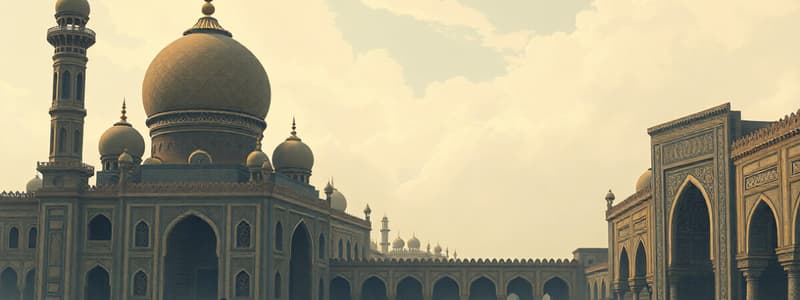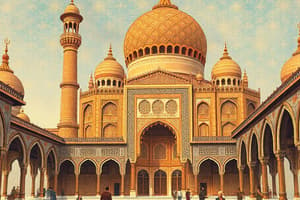Podcast
Questions and Answers
Which trade route primarily connected Asia, Africa, and the Mediterranean during 300-1500 CE?
Which trade route primarily connected Asia, Africa, and the Mediterranean during 300-1500 CE?
- Indian Ocean trade route
- Silk Road (correct)
- Trans-Saharan trade route
- Viking trade network
What was the primary product traded from the north to the south in the trans-Saharan trade route?
What was the primary product traded from the north to the south in the trans-Saharan trade route?
- Salt (correct)
- Gold
- Ivory
- Spices
What impact did the Romans have on the spread of trade networks?
What impact did the Romans have on the spread of trade networks?
- Establishment of roads across Europe (correct)
- Use of Viking ships
- Development of sea trade routes
- Expansion of the Silk Road
How did environmental factors contribute to the growth of exchange networks?
How did environmental factors contribute to the growth of exchange networks?
What major technological advancement was passed to Europe from Muslims?
What major technological advancement was passed to Europe from Muslims?
Which kingdoms benefited significantly from the trans-Saharan trade route?
Which kingdoms benefited significantly from the trans-Saharan trade route?
What role did the camel saddle play in trade during the period?
What role did the camel saddle play in trade during the period?
What religions developed and spread across Afro-Eurasia during this period?
What religions developed and spread across Afro-Eurasia during this period?
What was a significant factor contributing to the expansion of the Muslim Empire?
What was a significant factor contributing to the expansion of the Muslim Empire?
Who became the first caliph after Muhammad's death?
Who became the first caliph after Muhammad's death?
Which civilization was known for creating powerful states with prosperous trade networks in Mesoamerica?
Which civilization was known for creating powerful states with prosperous trade networks in Mesoamerica?
What led to the fall of the Han dynasty around 220 C.E.?
What led to the fall of the Han dynasty around 220 C.E.?
Which family ruled the Muslim Empire for 500 years until 1258?
Which family ruled the Muslim Empire for 500 years until 1258?
What was one impact of the collapse of classical empires on Afro-Eurasia?
What was one impact of the collapse of classical empires on Afro-Eurasia?
Which empire controlled a large territory stretching from the Roman Empire to Gupta India?
Which empire controlled a large territory stretching from the Roman Empire to Gupta India?
What followed the Tang dynasty in China, contributing to a long period of prosperity?
What followed the Tang dynasty in China, contributing to a long period of prosperity?
Which religion spread from West Africa to Central Asia?
Which religion spread from West Africa to Central Asia?
What technological advancement was introduced through trade that improved navigation?
What technological advancement was introduced through trade that improved navigation?
What environmental issue was particularly caused by increased trade in the Huang He River valley?
What environmental issue was particularly caused by increased trade in the Huang He River valley?
Which two religious groups were involved in the split of Christianity in 1054?
Which two religious groups were involved in the split of Christianity in 1054?
What was a major result of the Crusades starting in 1095?
What was a major result of the Crusades starting in 1095?
Which trade route supplied two-thirds of the world's gold?
Which trade route supplied two-thirds of the world's gold?
How did the camel saddle contribute to trade in Afro-Eurasia?
How did the camel saddle contribute to trade in Afro-Eurasia?
What effect did trade networks have on the spread of religions during this period?
What effect did trade networks have on the spread of religions during this period?
What is the significance of the hijab in the Muslim faith?
What is the significance of the hijab in the Muslim faith?
Which garment is typically worn by Muslim men in the Middle East?
Which garment is typically worn by Muslim men in the Middle East?
Which option describes a type of food that is prohibited in Islam?
Which option describes a type of food that is prohibited in Islam?
What role did Muhammad play in the origin of Islam?
What role did Muhammad play in the origin of Islam?
Which of the following best describes the Five Pillars of Islam?
Which of the following best describes the Five Pillars of Islam?
What is the primary reason that alcohol is prohibited in Islam?
What is the primary reason that alcohol is prohibited in Islam?
How did the influence of Islam spread after Muhammad's death?
How did the influence of Islam spread after Muhammad's death?
What is the basis of Islamic law, known as Shari'ah?
What is the basis of Islamic law, known as Shari'ah?
What is the primary type of attire worn by Hindu women?
What is the primary type of attire worn by Hindu women?
Which of the following foods is not allowed in Hinduism?
Which of the following foods is not allowed in Hinduism?
What is the drink known as Armita associated with in Hinduism?
What is the drink known as Armita associated with in Hinduism?
Which site is recognized as the birthplace of Buddha in Buddhism?
Which site is recognized as the birthplace of Buddha in Buddhism?
What does the principle of dharma represent in Hinduism?
What does the principle of dharma represent in Hinduism?
Which of the following is a holy site where Buddha gave his first sermon?
Which of the following is a holy site where Buddha gave his first sermon?
How did Hinduism primarily spread to Southeast Asia?
How did Hinduism primarily spread to Southeast Asia?
Which of the following is NOT considered one of the Vedas?
Which of the following is NOT considered one of the Vedas?
Flashcards are hidden until you start studying
Study Notes
The Rise and Fall of Empires
- The Muslim Empire emerged in the 7th century, spreading Islamic culture across three continents.
- The empire's origins are rooted in the teachings of Muhammad.
- The Umayyad family ruled the Muslim Empire for over 500 years, presiding over a golden age of Muslim culture.
- The Han dynasty of China collapsed in 220 C.E. due to political, economic, and social challenges.
- The Roman Empire disintegrated two centuries later, with Emperor Diocletian dividing the empire into eastern and western halves.
- The Gupta Empire, which ruled northern India for over two centuries, fell around 450 C.E. following a foreign invasion.
Global Trade Networks
- The Silk Road connected Asia, Africa, and the Mediterranean, playing a crucial role in trade during the Han and Mongol empires. Arab camel caravans significantly enhanced its operations.
- Sea trade routes facilitated connections between Korea, Japan, China, Southeast Asia, India, Southwest Asia, and East Africa.
- The trans-Saharan trade route linked Africa's Mediterranean coast with sub-Saharan regions, primarily exchanging salt from the north for gold from the south. This route was instrumental in supplying two-thirds of the world's gold and supporting the kingdoms of Ghana, Mali, and Songhai.
- Smaller trade networks operated in the Americas and the South Pacific, particularly among the island groups of Polynesia, Melanesia, and Micronesia.
The Spread of Religions
- Buddhism spread throughout Asia.
- Hinduism reached Southeast Asia through trade and migration.
- Islam expanded from West Africa to Central Asia.
- Christianity spread across Europe and Russia.
- Judaism extended from western Europe to Central Asia.
Religious Conflicts
- Muslim-Hindu conflicts arose in India.
- A split occurred between Roman Catholicism and Orthodox Christianity in 1054.
- The Crusades, initiated in 1095, saw conflicts between Christians and Muslims.
Technological Exchanges
- Arabic numerals, originating from India, were adopted by Muslims and later transmitted to Europe, laying the groundwork for modern mathematics.
- The camel saddle, invented in Arabia, revolutionized overland travel and trade in Afro-Eurasia.
- Significant advancements took place in irrigation, navigation, printing, and papermaking.
Environmental Impact of Trade
- The spread of diseases, including smallpox and bubonic plague, was a consequence of increased trade.
- Deforestation, soil erosion, and flooding, particularly in China's Huang He River valley, were environmental consequences of expanding agriculture and trade.
Population Changes
- The global population decreased from 257 million in 200 C.E. to 206 million in 700 C.E.
- Population growth occurred until 1000 C.E.
- The plague in the 1300s led to a decline but population started rising again by 1500.
The Vikings
- Viking trade expanded along sea and river routes across the Baltic and North seas, the Mediterranean, and Russian rivers.
- They traded furs, lumber, salt, glass, horses, woolens, and slaves.
Islam
- The origins of Islam lie in the revelations received by Muhammad in 610 C.E.
- Islam became the dominant faith in Arabia by 630 C.E.
- After Muhammad's death in 632 C.E., Muslim leaders expanded the religion's influence throughout the Middle East, North Africa, Spain, Central Asia, and India by 750.
- Islam is the second largest religion globally, with over a billion followers.
- Islamic law, known as Shari'ah, provides guidance on all aspects of life and adapts to modern challenges.
- Muslims believe in the Qur'an and the Sunnah.
- The Five Pillars of Islam comprise profession of faith, prayer, charity, fasting, and pilgrimage.
Hinduism
- Hinduism recognizes Brahman as a divine force with multiple manifestations.
- Dharma represents duty and moral values.
- Karma links actions and consequences.
- Hinduism developed over thousands of years drawing on India’s religious and cultural traditions.
- Hinduism has approximately 900 million followers, primarily in South Asia.
Buddhism
- The Four Noble Truths are a core element of Buddhist teachings.
- Buddhism spread through trade routes.
Studying That Suits You
Use AI to generate personalized quizzes and flashcards to suit your learning preferences.




